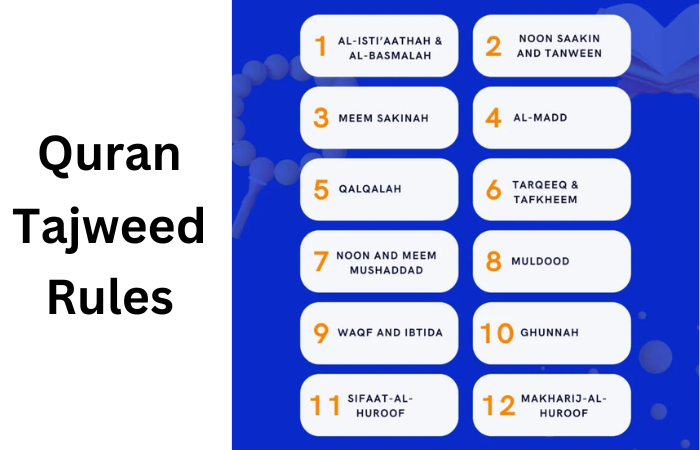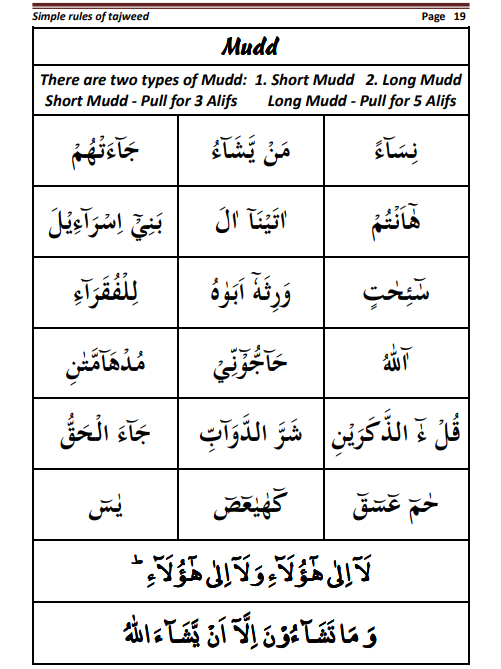Quran Tajweed Rules
-
Posted by
Mansab Awan

What's the Quran Tajweed Rules?
Quran Tajweed rules are guidelines for the correct recitation and reading of the Quran. Tajweed rules help to recite the Quran as it was revealed to Muhammad (SAW).
Another word,
Tajweed means – “To Perfect, Beautify, or Improve”
So, learning the Quran Tajweed to recite the Quran correctly. In the same way that Prophet Muhammad (PBUH) learned from Jibreel (AS).
Tajweed is the Quran’s grammar, ensuring correct pronunciation and recitation. It provides an error-free transmission of every word and sound, maintaining the authentic meaning of the Quranic text.
Here is a hadith specifically illustrating the reward of reciting beautifully narrated by A’ishah, may Allah be pleased with her:
“One who recites the Quran beautifully, smoothly, and precisely will be in the company of noble angels. As for the one who recites it with difficulty, stammering or stumbling through its verses, (s)he will have twice that reward.” [Al-Bukhari]”
Quran Tajweed rules ensure the Quran is recited and read accurately. There are twelve Tajweed rules, and the Quran uses each differently.
12 Basic Quran Tajweed Rules
12 basic types of Tajweed rules to learn Quran with Tajweed, each of which has its further sub-rules.
The rules mentioned below describe or characterize Tajweed (descriptors). If you are planning to learn to read the Quran with proper Tajweed, you should learn it with certified Quran teachers.
In this blog, we’ll only focus on the 12 types of Quran Tajweed and its rules.
List of Quran Tajweed Rules and Sub-Rules:
- Noon Sakinah & Tanween
- Idhaar (to make clear)
- Idghaam (to merge)
- Iqlaab (to convert)
- Ikhfaa (to hide)
- Noon & Meem Mushaddad
- Meem Sakinah
- Ikhfaa Shafawy
- Idghaam Shafawy
- Izhaar Shafawy
- Qalqalah
- Al-Madd
- Two Beat Madd
- Flexible Madd (two, four, or six)
- Four Beat Madd
- Six Beat Madd
Following the Quran Tajweed rules helps readers properly communicate the message of the Quran’s holiness. To satisfy the essence of the Quran, we highly advise you to memorize it via Tajweed.
Tajweed symbols are used in the Quran; these markings and notations are used to show the proper text pronunciation and recitation based on Tajweed regulations.
These icons help readers see every letter’s correct traits, including elongation, pronunciation, and emphasis.

Understand Each Tajweed Rule in Depth with Examples
Noon Sakinah & Tanween
This Tajweed rule concerns the vowels and letters that create the ‘nnn‘ sound, such as:
- noon sakinah نْ
- letters with tanween (a double vowel that adds the noon sound to the applied letter)
- بًا (ban)
- بٍ (bin)
- بٌ (boon)
Idhaar (to make clear)
If noon sakinah نْ or a tanween is followed by these 6 letters [ء ه ع ح غ خ], then pronounce the noon normally (without ghunnah.)
[ ء ه ع ح غ خ ]
Idghaam (to merge)
There are two forms of Idghaam: one with ghunnah and one without.
With Ghunnah: If these letters [ي ن م و] are followed after a noon sakinah or tanween, then skip the ghunnah from the noon, but instead apply the ghunnah with the followed letter.
[ ي ن م و ]
Iqlaab (to convert)
If there is a [ب] followed after a noon sakinah or tanween, then turn the ghunnah into a [م] by pronouncing the meem, but still pronouncing the [ب] afterward.
Ikhfaa (to hide)
Ikhfaa applies to the remaining letters not mentioned [ ت ث ج د ذ س ش ص ض ط ظ ف ق ك ]. One should hide the noon sakinah or tanween but apply ghunnah. The level of ghunnah depends on the specific letter that is followed after. Adjust the lips and mouth as if you are about to pronounce the letter after the noon sakinah or tanween.
[ ت ث ج د ذ س ش ص ض ط ظ ف ق ك ]
Noon & Meem Mushaddad
This is a simple Tajweed rule that only applies to two letters.
If a noon or a meem has shaddah, then pronounce a 2 beat ghunnah. This is still applied when stopping on the letter. Careful not to extend the sound of the letter, but only the ghunnah.
ثُمَّ = thummma
إِنَّ = innna
Meem Sakinah
This Tajweed rule has the same sub-rulings as noon sakinah and tanween, but not as many specific letter applications.
Ikhfaa Shafawy
If a [ب] is followed after a meem sakinah, then apply a ghunnah while hiding the meem sakin before continuing to the [ب].
Idghaam Shafawy
If the start of the word begins with a meem and is followed with a meem sakinah, then merge the words through the meem and apply ghunnah.
Izhaar Shafawy
This sub-rule applies to the rest of the letters when they follow a meem sakinah. Simply pronounce the meem clearly without ghunnah and no merging to the next letter.
أَلَمْ تَرَ = Alam tara
Qalqalah
This Tajweed rule means ‘echoing’ and the application is to create an echoing sound at the end of the pronunciation of certain letters. The purpose of this rule is to differentiate between letters that have similar sounds when one stops on them (letter with sukoon, end of ayah, or taking a breath). It also helps create flow within the recitation.
The Qalqalah letters are as follows:
[ ق ط ب ج د ]
There are three places that the reciter needs to be wary of when performing Qalqalah.
When it occurs in the middle of a word, then it is a quick echo and a smooth continuation to the next letter. It is like a shaddah, but without the clear extension of the vowel.
تَجْرِي = tajeree
If one is stopping on a word that ends in Qalqalah, make the echoing a little more pronounced.
اللَّهُ الصَّمَدُ = Allahu samadda
If one is stopping on a word that has Qalqalah and it has a shaddah, one needs to have a jerking echo.
لَهَبٍ وَتَبَّ = lahabiuuu wa tabbbaa


Al-Madd
Madd affects letters which the reciter needs to stretch longer than they usually would. The elongation differs depending on the situation and the symbol present. The length of the Madd is usually described by the number of harakat or beats. Each different sub-rule has its name, but to keep things clear and concise they are grouped by the number of beats instead. The names of all of the rules are provided in one of the referenced links.
The madd letters are:
[ ا و ى ]
Two Beat Madd
When one of the Madd letters is connected to another letter not followed by a hamza or letter with sukoon, then elongate it for only two beats. This is referred to as the natural Madd. If a hamza precedes a Madd letter, then the prolongation is still only 2 beats.
دِينُكُمْ = dee nukum
يَا = yaa
عَابِدُونَ = A’aa be doona
If one stops at a word that ends in a tanween fatha, turn the tanween into an alif Madd.
أَفْوَاجًا = Aff waa jaa
Flexible Madd (two, four, or six)
If one stops at a word in which there is a Madd before the last letter, then one can exaggerate the Madd to four or six beats. Two beats is still the minimum required here and one can do the elongation to four or six only if they stop at the word.
إِلَٰهِ النَّاسِ = ilaa hinnnaaaas
Four Beat Madd
If there is a Madd letter in the middle of a word and a hamza follows it, the Madd should be prolonged by four or five beats. Similarly, if the word ends in a Madd and the beginning of the next word starts with a hamza, then the Madd should again be prolonged by four or five beats.
إِذَا جَاءَ = idhaa jaaaa a
(Although both dhal and ja contain an alif Madd, ja is extended longer due to the hamza)
Six Beat Madd
If a letter with a shaddah follows a Madd letter, then the Madd letter should be prolonged for 6 beats.
وَلَا الضَّالِّينَ = wa laddaaaaaalleeen
If a letter with a sukoon follows after a Madd letter, then the Madd letter should be prolonged for 6 beats.

Waqaf in Tajweed, it's Symbols, and Rules
The Three Most Used Tajweed Emblems
The symbol of sajda (prostration) is indicated by a small superscript symbol like an inverted V or caret (^) above the Arabic letter that should be the word’s first letter in the verse where the sajda is required. Sajda symbolizes a verse in which prostration (sujood) is mandated. When Muslims encounter it during recitation, it inspires them to do a quick act of prayer, bending in respect to Allah.
Secondly, there is a place in the Quranic recitation called Waqf-e-Taam when one must halt completely. Waqf e Taam (): Signifies the end of a verse, requiring a complete stop. It marks a required stop that guarantees correct comprehension and introspection of the passage.
One of the Tajweed symbols in the Quran where halting is required is Waqf-e-Lazim. Must stop مـ This symbol commands the reader to stop here, which means to stop. It marks a turning point when stopping is necessary to understand and introspect the book’s meaning.



Why Are Rules on Tajweed Crucial in the Quran?
Tajweed regulations’ have a very significant role in the Quran:
- Learning Tajweed guarantees precise pronunciation of every word in the Quran, preventing any meaning change brought about by mispronunciation.
- Tajweed allows adherents to establish a closer connection with the Quran. It is said that the Quran would intervene for individuals who perform competent Day of Resurrection recitations.
- Reciting the Quran with Tajweed helps one benefit greatly from Allah. Every letter said correctly is doubled in honor of Allah’s unbounded kindness.
Quran Tajweed Rules Learning: 5 Essential Tips
You must follow a systematic approach to picking Tajweed quickly. However, keep in mind that learning Tajweed will require time and work. Follow the given guidelines to learn it quickly.
Guidelines from an Expert
An expert Tajweed teacher can guide you better than any other source of learning.
Dedicated Time
Like all other forms of skills, you need to have a dedicated time for practicing Tajweed
Use Multiple Resources
Instead relying on one source of knowledge, use varying sources
Master the Arabic Letters Pronunciation
It would be best to master the pronunciation of Arabic letters before mastering the Tajweed.
Clarity Over Speed
Focus on clarity; more than speed is needed for beginners. Do not try to go ahead until you have developed a strong foundation.
Should One Study the Quran without Tajweed?
It is neither unlawful nor banned to read the Quran without Tajweed. Though not required, Tajweed guarantees proper quran recitation and assists with pronunciation. It just helps one to articulate every syllable properly.
Thus, reading the Quran without Tajweed is not problematic as the Quran does not explicitly mention Tajweed, and no explicit need is indicated. It is more about personal development in Quran recitation than about a rigid duty.
FINAL WORDS
Learning Tajweed rules connects one deeply with the Quran’s sacred text and does not develop a talent alone. These rules, which control the exact pronunciation and melodic recitation of Quranic verses, are very important for both novices and experienced students. After focusing and displaying full enthusiasm, beginners may quickly learn Tajweed rules in six months.
Learning Tajweed on sites like Learn Quran Classes guarantees adherence to Quranic recitation guidelines and increases spiritual involvement and knowledge.